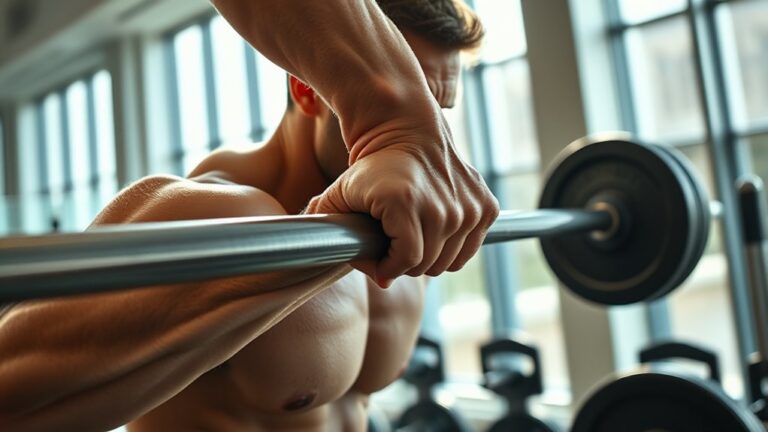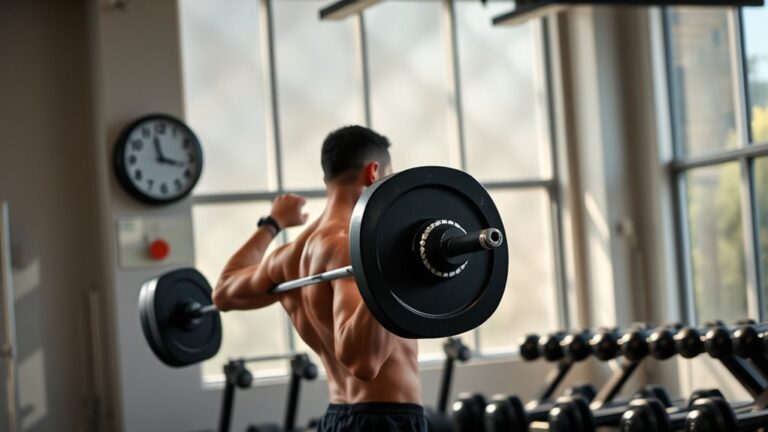The Best Training Methods for Maximizing Neuromuscular Adaptation
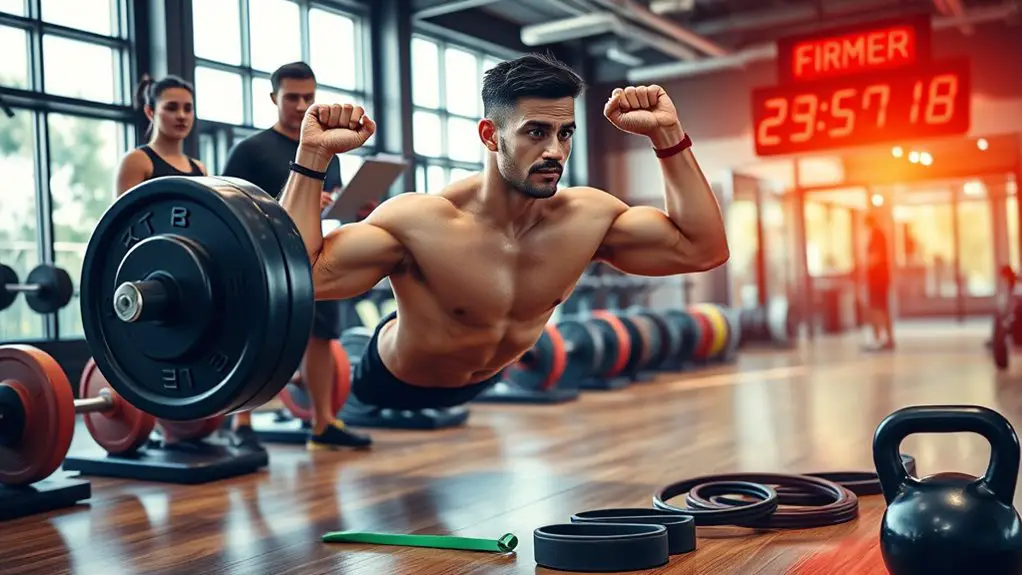
To maximize neuromuscular adaptation, you should incorporate strength training, plyometrics, Olympic lifting, and sport-specific drills into your regimen. Strength training enhances motor unit recruitment and muscle fiber efficiency, while plyometrics stimulate fast-twitch fibers for power. Olympic lifting improves mobility and joint stability, and sport-specific drills enhance coordination. Including speed and agility drills boosts reaction time and neuromuscular coordination. A well-rounded approach can lead to significant performance improvements. Discover further methods to elevate your training regimen.
Understanding Neuromuscular Adaptation
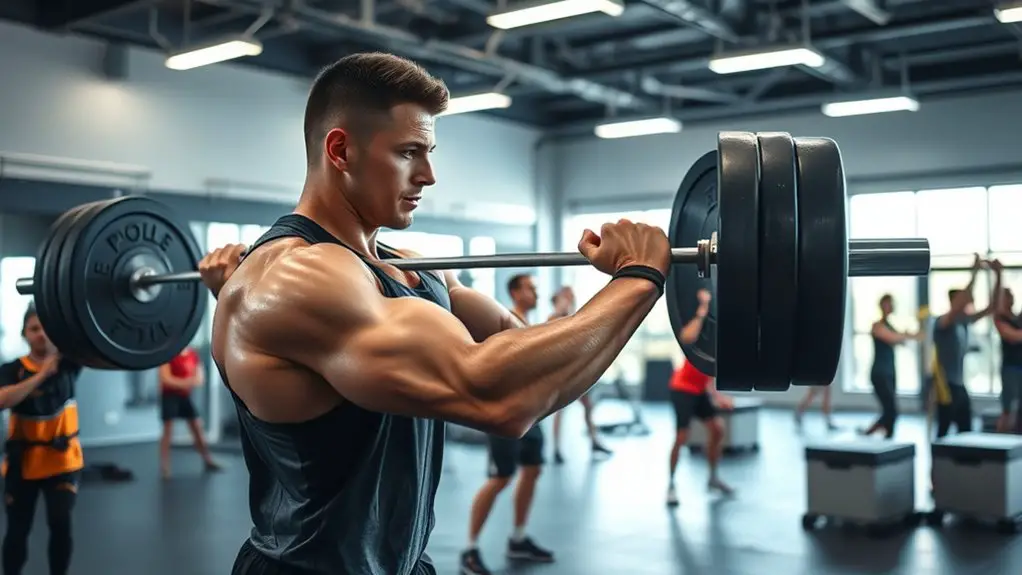
While many athletes focus on strength and endurance, understanding neuromuscular adaptation is essential for enhancing performance. Neuromuscular adaptation involves the changes in neuromuscular pathways that occur in response to training stimuli. These adaptation mechanisms enable your body to recruit muscle fibers more efficiently, improving both coordination and power output.
When you engage in consistent training, your central nervous system adapts by enhancing synaptic efficiency and increasing motor unit recruitment. This means that, over time, you’ll be able to activate more muscle fibers simultaneously, resulting in improved performance. Additionally, neuromuscular adaptations can lead to faster reaction times and better overall athletic skill.
To maximize these benefits, you should incorporate varied training modalities that challenge your neuromuscular pathways. This approach not only promotes greater adaptation but also reduces the risk of plateauing in performance. Understanding these principles helps you tailor your training for superior results.
Importance of Strength Training
Strength training plays a pivotal role in enhancing neuromuscular adaptation, as it directly influences the efficiency of muscle fiber recruitment and overall athletic performance. By systematically applying resistance, you stimulate muscle hypertrophy and improve strength endurance, leading to ideal neuromuscular function.
- Increases motor unit recruitment
- Enhances rate coding for muscle contractions
- Promotes structural changes in muscle fibers
- Improves coordination and balance
- Reduces injury risk through stronger connective tissues
These adaptations not only boost your physical capabilities but also contribute to better performance in various sports. Furthermore, strength training helps in developing a solid foundation for more advanced training modalities, ensuring that you can effectively engage in complex movements. By focusing on strength training, you set the stage for long-term athletic success and resilience, making it an indispensable component of any training regimen aimed at maximizing neuromuscular adaptation.
The Role of Plyometrics
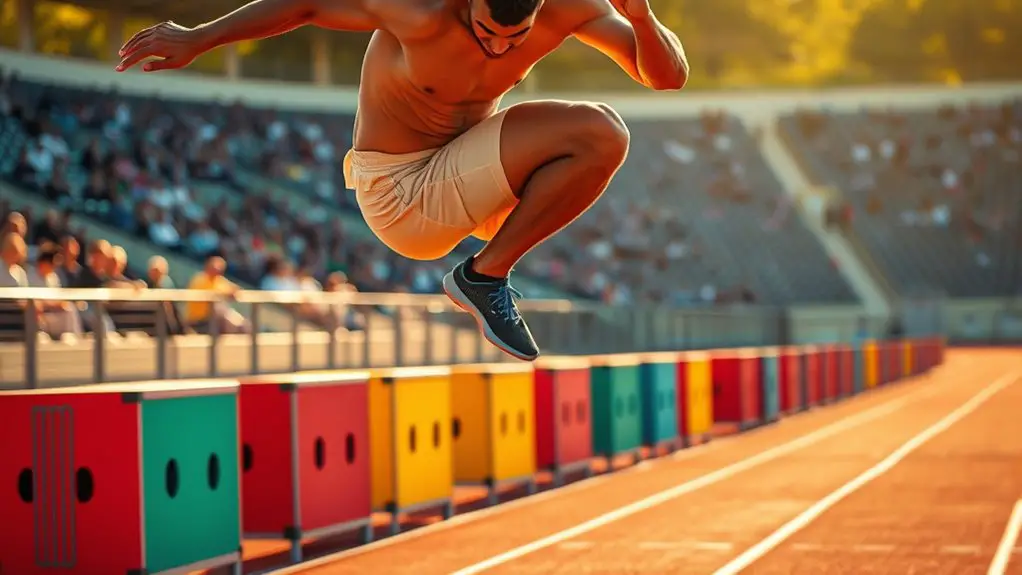
Plyometrics, which involve explosive movements that capitalize on the stretch-shortening cycle, play an indispensable role in neuromuscular adaptation by enhancing power output and improving athletic performance. By incorporating plyometric techniques, you’re able to stimulate fast-twitch muscle fibers, which are essential for generating explosive power. Research shows that these dynamic movements, such as jump squats and box jumps, can increase not only vertical leap but also sprint speed, making them invaluable for athletes across various sports.
Moreover, plyometric training induces greater neuromuscular efficiency by improving the communication between your nervous system and muscles. This adaptation allows for quicker muscle contractions and enhanced reaction times. To maximize benefits, it’s imperative to integrate plyometric exercises into your routine progressively, ensuring proper technique to minimize injury risk. Additionally, combining bodyweight exercises with plyometric drills can further enhance strength and power outputs. Ultimately, by harnessing the power of plyometrics, you can greatly boost your athletic capabilities and overall performance.
Incorporating Olympic Lifting
Building on the foundation of explosive training methods like plyometrics, incorporating Olympic lifting can further enhance neuromuscular adaptation and overall athletic performance. This training modality focuses on Olympic technique, emphasizing explosive strength and power development vital for athletes.
Consider the following key aspects when integrating Olympic lifting into your regimen:
- Lifting variations: Incorporate snatches and clean-and-jerks for diverse stimulus.
- Technique refinement: Master the Olympic lifts to guarantee peak performance and safety.
- Mobility training: Improve range of motion and joint stability, essential for effective lifting.
- Power development: Enhance your ability to generate force rapidly, translating to improved performance in sports.
- Competitive edge: Utilize Olympic lifting to differentiate yourself from competitors.
Benefits of Speed and Agility Drills
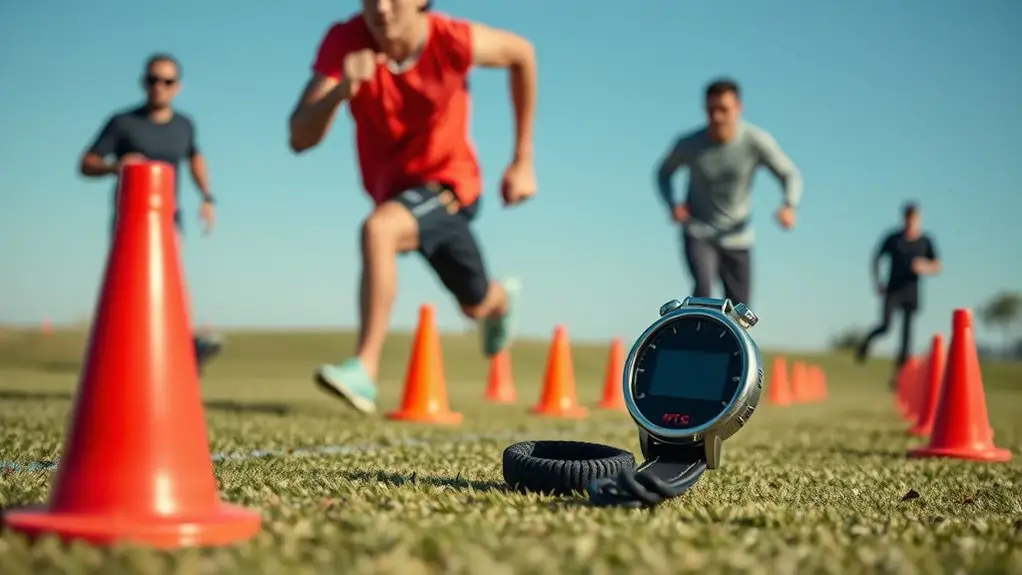
Speed and agility drills offer numerous benefits that are vital for enhancing overall athletic performance. Engaging in speed drills can greatly improve your acceleration, top speed, and overall sprinting mechanics. Research indicates that these drills enhance neuromuscular coordination, which translates to better muscle recruitment during high-intensity activities.
On the other hand, agility drills focus on rapid changes in direction and body control. These drills help improve your reaction time and enhance your ability to maintain balance while executing complex movements. Studies show that incorporating both speed and agility drills into your training regimen can lead to superior performance outcomes in sports requiring quick, explosive movements.
Moreover, these drills stimulate the proprioceptive system, fostering better body awareness and movement efficiency. By integrating speed and agility drills, you’re not just training your body; you’re refining the neural pathways essential for peak athletic performance.
The Impact of Resistance Training Variations
While many athletes focus on specific exercises, understanding the impact of resistance training variations can considerably enhance neuromuscular adaptation and overall performance. By incorporating different resistance variations, you can optimize several factors critical to your training regimen:
- Training periodization allows for systematic progression and recovery.
- Load progression guarantees continuous challenge and adaptation.
- Exercise selection broadens muscle recruitment and reduces plateaus.
- Intensity modulation helps manage fatigue while maximizing effectiveness.
- Volume control tailors training frequency to individual recovery rates.
Implementing these variation strategies not only stimulates different adaptation mechanisms but also promotes structural and functional improvements. For instance, utilizing effective high row machine alternatives can further diversify your training routine and target upper back muscles more effectively. By strategically varying your resistance training, you can facilitate enhanced muscle recruitment and prevent overtraining. This multifaceted approach will not only bolster your neuromuscular efficiency but also improve your overall athletic performance.
Utilizing Functional Training Techniques
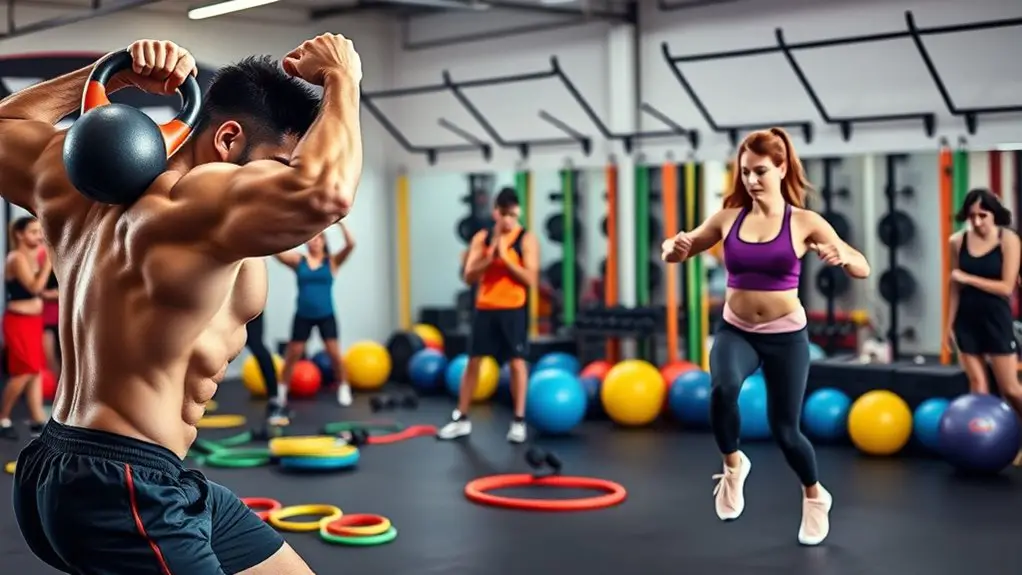
When utilizing functional training techniques, you’re engaging in exercises that enhance core stability, facilitate multi-joint movements, and incorporate sport-specific drills. Research indicates that these methods can markedly improve neuromuscular coordination and overall athletic performance. By systematically integrating these elements into your training regimen, you’ll optimize your body’s ability to adapt and respond to various physical demands.
Core Stability Exercises
Core stability is vital for optimizing functional movement and preventing injury, as it forms the foundation for all dynamic activities. Effective core stability exercises enhance core activation, ensuring your body remains stable during various movements. Incorporating stability training techniques can greatly improve your performance. Here are some key aspects to keep in mind:
- Engaging multiple muscle groups enhances overall strength.
- Focus on maintaining neutral spine alignment for injury prevention.
- Utilize unstable surfaces, like stability balls, to challenge your core.
- Integrate dynamic movements to mimic real-life activities.
- Consistency in practice is essential for long-term adaptation.
Multi-Joint Movements
Multi-joint movements are essential for enhancing neuromuscular adaptation, as they engage multiple muscle groups and joints simultaneously. Incorporating squat variations and deadlift techniques into your routine can greatly improve joint stability and muscle coordination. Utilizing compound lifts like the bench press and overhead press not only targets major muscle groups but also promotes functional strength. Integrating mobility drills enhances flexibility, further aiding in the effective execution of these lifts. Additionally, resistance bands can be used to modify powerlifting strategies, providing variable resistance that challenges both strength and stability. By focusing on these multi-joint exercises, you’ll maximize neuromuscular adaptations, leading to improved performance and reduced injury risk during training.
Sport-Specific Drills
Incorporating sport-specific drills into your training routine is vital for optimizing neuromuscular adaptation, as these exercises mimic the movements and demands of your chosen sport. The concept of drill specificity is significant; it guarantees that the skills you develop during training directly transfer to your performance. By focusing on the unique motor patterns and energy systems required in your sport, you enhance skill transfer and improve overall efficiency.
- Enhances coordination and proprioception
- Increases muscle memory for specific actions
- Develops sport-related endurance and strength
- Improves decision-making under pressure
- Promotes injury prevention through functional movement patterns
Recovery and Its Influence on Adaptation

Recovery plays an essential role in enhancing neuromuscular adaptation, as adequate rest allows your body to repair and strengthen muscle fibers. Studies indicate that sleep quality greatly impacts hormonal balance, which is essential for recovery and muscle growth. By prioritizing both rest and sleep, you can optimize your training outcomes and improve overall performance.
Importance of Rest
While many athletes focus on training intensity and frequency, neglecting the role of rest can greatly hinder neuromuscular adaptation. Effective recovery strategies are vital for optimizing performance and enhancing muscle growth. Here are some key points to take into account about the importance of rest:
- Rest techniques allow for muscle repair and growth.
- Adequate rest reduces the risk of overtraining and injury.
- Hormonal balance, including testosterone and cortisol levels, is influenced by recovery.
- Mental fatigue can impair performance; rest helps restore focus.
- Active recovery methods can aid in muscle recovery and reduce soreness.
Incorporating these rest techniques into your training program will guarantee that you maximize adaptation, ultimately leading to improved performance and longevity in your athletic pursuits.
Sleep Quality Effects
Although many athletes prioritize training volume and intensity, the quality of sleep they achieve plays a pivotal role in neuromuscular adaptation and overall performance. Sleep hygiene, including a conducive sleep environment and adherence to circadian rhythms, is essential for optimizing sleep duration and quality. Sleep deprivation can disrupt hormonal balance, negatively impacting recovery strategies and performance. Prioritizing quality naps can enhance restorative sleep cycles, aiding muscle repair and mental clarity. Implementing relaxation techniques before bed can further improve sleep quality. Athletes should be mindful of these factors, as adequate rest not only supports recovery but also maximizes the benefits of training, ultimately leading to superior neuromuscular adaptation.
Frequently Asked Questions
How Long Does It Take to See Neuromuscular Adaptations?
You’ll typically start noticing neuromuscular adaptations within a time frame of 2 to 4 weeks, depending on your training frequency and intensity. As you consistently engage in resistance training, your body undergoes neural improvements that enhance muscle coordination and efficiency. However, individual variations exist, influenced by factors like genetics and prior experience. To optimize these adaptations, maintaining a regular training schedule is essential to stimulate ongoing progress and improvement.
Can Neuromuscular Adaptation Occur Without Weightlifting?
Yes, neuromuscular adaptation can occur without weightlifting. Bodyweight exercises, like push-ups and squats, engage your muscles and nervous system, promoting strength and coordination. Research shows that these movements can improve athletic performance by enhancing motor unit recruitment and firing rates. Although weightlifting is often emphasized, bodyweight training effectively stimulates neuromuscular adaptations, allowing you to gain strength and improve function without traditional weights. It’s all about the intensity and consistency of your training.
Are There Age Limits for Effective Neuromuscular Training?
Did you know that studies show neuromuscular training can enhance strength in seniors by up to 30%? There aren’t strict age limits for effective neuromuscular training; youth training can set a solid foundation, while older adults can also experience significant adaptations. Research indicates that seniors engaging in resistance and balance training improve their functional abilities, demonstrating that age should never deter you from pursuing neuromuscular adaptations. It’s never too late to start training!
How Does Nutrition Affect Neuromuscular Adaptation?
Nutrition plays an essential role in neuromuscular adaptation. You need to maintain a proper macronutrient balance—adequate proteins for muscle repair, carbohydrates for energy, and fats for overall health. Additionally, hydration levels greatly influence your performance and recovery; dehydration can impair muscle function and cognitive processes. Ensuring you meet these nutritional needs can optimize your training outcomes, enhancing both strength gains and overall neuromuscular efficiency in your workouts.
Can Neuromuscular Adaptations Be Reversed?
They say “use it or lose it,” and this certainly applies to neuromuscular adaptations. When you cease training, adaptation reversal can occur, leading to diminished strength and coordination. Studies show that prolonged training cessation can result in significant decreases in muscle fiber size and neural efficiency. The timeline for these reversals varies, but consistently, the longer you stop training, the more pronounced the effects will be. Staying active is essential for maintaining your neuromuscular gains.
